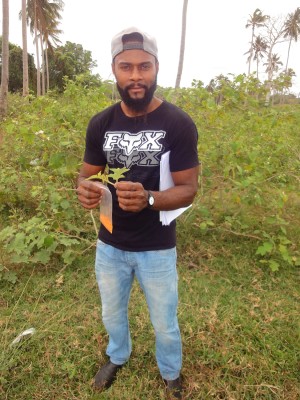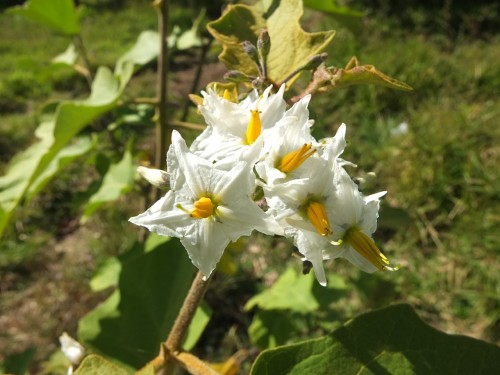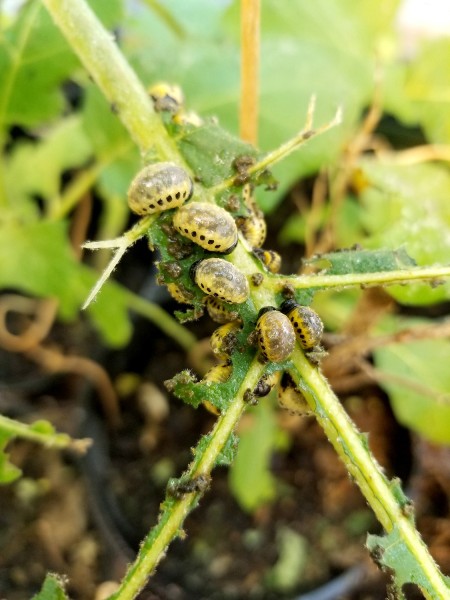On the way to Solving a Prickly Problem

Jimmy Peters (Biosecurity Vanuatu)
A major problem in pastures, roadsides, and wasteland, S. torvum can grow up to 6 m tall and form dense, impenetrable thickets. Like most Solanum species the fruits are readily eaten by birds, which then spread the seeds. In addition to being a pasture weed, S. torvum is a reservoir host of fruit flies (Ceratitis capitata, Bactrocera dorsalis, and B. latifrons) that are pests of fruit and vegetable crops. Although the fruits of S. torvum plants are sometimes used in cooking, there are reports of poisoning associated with people eating unripe berries or more toxic phenotypes. There is evidence that the plant is poisonous to livestock, although they generally do not eat it, and so it can quickly form dense stands that shade out desirable pasture plants. “Pico is having a major impact on the beef industry in Vanuatu, so we were asked to look for natural enemies to better manage it there,” said Quentin Paynter, who is leading this project.
Deciding where to prospect for natural enemies was tricky due to uncertainty regarding the native range. Some authors consider S. torvum to be native from Florida and southern Alabama through to the West Indies, and from Mexico through Central America and South America through to Brazil, while others believe it is native to the Antilles but has been dispersed to many tropical regions in both the New and Old Worlds. This is a very large area covering numerous countries and islands, so we needed some clues about the best places to look for potential natural enemies to refine our search. A literature review indicated that most natural enemies that are likely to be specific to S. torvum occur in the Antilles, Mexico, and Central America. “We prioritised Jamaica as the first place to look because host-specific natural enemies should be present, and it was a relatively easy place to work, in terms of logistics, such as arranging export permits,” said Quentin.

Solanum torvum flower
“To support the literature review we undertook a molecular study, which has shown that populations of S. torvum in the Pacific are genetically very similar to those in the Antilles,” said Caroline Mitchell, who analysed the samples and the data. The study confirmed the Antilles to be the best place to look for natural enemies.
A literature review turned up a beetle (Leptinotarsa undecimlineata) that looked like a promising candidate. We were fortunate to be able to obtain some of these beetles from Jamaica shortly before the Covid-19 pandemic struck, bringing all overseas exploration to a halt for several years. The beetles have been intensively studied inside our containment facility in Auckland ever since. Both the adults and larvae feed on the foliage and, being quite a large beetle (1 cm long) are quite voracious. “We have had to periodically cull some beetles to avoid being eaten out of house and home,” said Zane McGrath, who has been caring for the colony.
When confined in laboratory conditions, some candidate agents feed and develop on plants they would not attack in the field, particularly in no-choice tests, either through desperation or disruption of normal host-seeking behaviour. Rejecting an agent because it can develop on a non-target plant species in a no-choice scenario risks erroneously rejecting a safe agent. When a candidate behaves unusually under laboratory conditions, considerably more testing is required to work out what is going on and to evaluate safety. There are many economically important species in the Solanum genus, including potatoes, tomatoes, and eggplants, as well species that are native to the Pacific. “Some of these species, such as eggplant, belong to Leptostemonum, the same subgenus as S. torvum, so we suspected that the host-range testing required was likely to be quite complex,” said Quent.

Pico beetle larvae
Nevertheless, no-choice tests ruled out all test plants as beetle hosts except for eggplant (S. melongena), but there was very strong evidence that the no-choice tests overestimated the risk posed to eggplant. Eggplant is cultivated extensively throughout the regions where L. undecimlineata is present, and the literature review found no records of eggplant being attacked over the bulk of the beetle’s range in Mexico, Colombia, and the Antilles, including Jamaica, where the beetles were sourced. “There was just one record of L. undecimlineata feeding on eggplant in Central America, which was described as minor and rare, and was likely to be a case of spillover attack from beetles dispersing from nearby native Solanum hosts,” said Quent.
Confining candidate agents on test and target plants in a no-choice manner does not allow them to use their normal host-seeking cues during pre-alightment. Test plants that can support the development of a candidate agent are likely to be at low risk of significant non-target attack if a candidate agent is not attracted to the olfactory and/or visual cues they produce. “Fortuitously a study had been done in the 1970s looking at the response of L. undecimlineata beetles to odour cues in Cuba, which found they were attracted by the scent of S. torvum but not eggplant,” confirmed Quent. This may explain why, during both no-choice and choice tests, beetles laid many more eggs on S. torvum compared to eggplant, even in relatively constrained laboratory conditions.
Furthermore, a multiple generation test indicated that eggplant is a very poor long-term host. Adult female beetles reared on eggplant laid fewer eggs than those reared on S. torvum, and the survival of the resulting F2 offspring was 19 times higher on S. torvum compared to eggplant. “For every pair of F1 beetles reared on S. torvum we reared 32.3 adult F2 beetles, indicating strong population growth. In contrast, for every pair of F1 beetles reared on eggplant we only reared 0.03 adult F2 beetles, indicating that L. undecimlineata reared exclusively on eggplant will soon decline to extinction, so the worst-case scenario could only ever be spillover attack,” said Zane. This result also indicates that because eggplant is such a poor host plant there should be a strong selection pressure against females that lay on eggplant. It follows that natural selection is not likely to result in L. undecimlineata broadening its host range to include eggplant.
So, after 3 years of careful testing it has been concluded that while minor spillover feeding on eggplant cannot be ruled out, the benefits of releasing L. undecimlineata are likely to greatly outweigh the risks. An import risk assessment is now being prepared for Vanuatu.
Funding
This project is funded by the New Zealand Ministry of Foreign Affairs and Trade.
Contact

